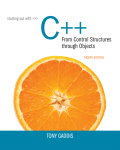
EBK STARTING OUT WITH C++
8th Edition
ISBN: 8220100794438
Author: GADDIS
Publisher: PEARSON
expand_more
expand_more
format_list_bulleted
Question
Chapter 20, Problem 16RQE
Program Plan Intro
Binary tree:
- Binary tree is a non-linear data structure.
- Binary tree contains node such as root node that is pointed to two child nodes.
- A root node will have left reference node and right reference node.
- Binary tree will contain more than one self-referenced field.
Searching data in binary tree:
- Binary tree suits best when searching large amount data, because it will consume less amount of time, since the search is based on the indexing
- In case of searching the data in standard linked list it is a linear, the search will be performed for the one element to another element till the search element is found in a sequential manner.
- In a binary tree, the data are stored in form of organized key structure, such that the search is performed based on the index values.
- It facilitates the search such that when a particular element is searched it looks for the index value that is stored directly, instead of searching each and every element that is present in the binary tree.
Expert Solution & Answer
Want to see the full answer?
Check out a sample textbook solution
Students have asked these similar questions
Describe three (3) Multiplexing techniques common for fiber optic links
Could you help me to know features of the following concepts:
- commercial CA
- memory integrity
- WMI filter
Briefly describe the issues involved in using ATM technology in Local Area Networks
Chapter 20 Solutions
EBK STARTING OUT WITH C++
Ch. 20.1 - Prob. 21.1CPCh. 20.1 - Prob. 21.2CPCh. 20.1 - Prob. 21.3CPCh. 20.1 - Prob. 21.4CPCh. 20.1 - Prob. 21.5CPCh. 20.1 - Prob. 21.6CPCh. 20.2 - Prob. 21.7CPCh. 20.2 - Prob. 21.8CPCh. 20.2 - Prob. 21.9CPCh. 20.2 - Prob. 21.10CP
Ch. 20.2 - Prob. 21.11CPCh. 20.2 - Prob. 21.12CPCh. 20 - Prob. 1RQECh. 20 - Prob. 2RQECh. 20 - Prob. 3RQECh. 20 - Prob. 4RQECh. 20 - Prob. 5RQECh. 20 - Prob. 6RQECh. 20 - Prob. 7RQECh. 20 - Prob. 8RQECh. 20 - Prob. 9RQECh. 20 - Prob. 10RQECh. 20 - Prob. 11RQECh. 20 - Prob. 12RQECh. 20 - Prob. 13RQECh. 20 - Prob. 14RQECh. 20 - Prob. 15RQECh. 20 - Prob. 16RQECh. 20 - Prob. 17RQECh. 20 - Prob. 18RQECh. 20 - Prob. 19RQECh. 20 - Prob. 20RQECh. 20 - Prob. 21RQECh. 20 - Prob. 22RQECh. 20 - Prob. 23RQECh. 20 - Prob. 24RQECh. 20 - Prob. 25RQECh. 20 - Prob. 1PCCh. 20 - Prob. 2PCCh. 20 - Prob. 3PCCh. 20 - Prob. 4PCCh. 20 - Prob. 5PCCh. 20 - Prob. 6PCCh. 20 - Prob. 7PCCh. 20 - Prob. 8PC
Knowledge Booster
Similar questions
- For this question you will perform two levels of quicksort on an array containing these numbers: 59 41 61 73 43 57 50 13 96 88 42 77 27 95 32 89 In the first blank, enter the array contents after the top level partition. In the second blank, enter the array contents after one more partition of the left-hand subarray resulting from the first partition. In the third blank, enter the array contents after one more partition of the right-hand subarray resulting from the first partition. Print the numbers with a single space between them. Use the algorithm we covered in class, in which the first element of the subarray is the partition value. Question 1 options: Blank # 1 Blank # 2 Blank # 3arrow_forward1. Transform the E-R diagram into a set of relations. Country_of Agent ID Agent H Holds Is_Reponsible_for Consignment Number $ Value May Contain Consignment Transports Container Destination Ф R Goes Off Container Number Size Vessel Voyage Registry Vessel ID Voyage_ID Tonnagearrow_forwardI want to solve 13.2 using matlab please helparrow_forward
- a) Show a possible trace of the OSPF algorithm for computing the routing table in Router 2 forthis network.b) Show the messages used by RIP to compute routing tables.arrow_forwardusing r language to answer question 4 Question 4: Obtain a 95% standard normal bootstrap confidence interval, a 95% basic bootstrap confidence interval, and a percentile confidence interval for the ρb12 in Question 3.arrow_forwardusing r language to answer question 4. Question 4: Obtain a 95% standard normal bootstrap confidence interval, a 95% basic bootstrap confidence interval, and a percentile confidence interval for the ρb12 in Question 3.arrow_forward
arrow_back_ios
SEE MORE QUESTIONS
arrow_forward_ios
Recommended textbooks for you
 C++ Programming: From Problem Analysis to Program...Computer ScienceISBN:9781337102087Author:D. S. MalikPublisher:Cengage Learning
C++ Programming: From Problem Analysis to Program...Computer ScienceISBN:9781337102087Author:D. S. MalikPublisher:Cengage Learning New Perspectives on HTML5, CSS3, and JavaScriptComputer ScienceISBN:9781305503922Author:Patrick M. CareyPublisher:Cengage Learning
New Perspectives on HTML5, CSS3, and JavaScriptComputer ScienceISBN:9781305503922Author:Patrick M. CareyPublisher:Cengage Learning Systems ArchitectureComputer ScienceISBN:9781305080195Author:Stephen D. BurdPublisher:Cengage Learning
Systems ArchitectureComputer ScienceISBN:9781305080195Author:Stephen D. BurdPublisher:Cengage Learning EBK JAVA PROGRAMMINGComputer ScienceISBN:9781337671385Author:FARRELLPublisher:CENGAGE LEARNING - CONSIGNMENTProgramming Logic & Design ComprehensiveComputer ScienceISBN:9781337669405Author:FARRELLPublisher:Cengage
EBK JAVA PROGRAMMINGComputer ScienceISBN:9781337671385Author:FARRELLPublisher:CENGAGE LEARNING - CONSIGNMENTProgramming Logic & Design ComprehensiveComputer ScienceISBN:9781337669405Author:FARRELLPublisher:Cengage

C++ Programming: From Problem Analysis to Program...
Computer Science
ISBN:9781337102087
Author:D. S. Malik
Publisher:Cengage Learning

New Perspectives on HTML5, CSS3, and JavaScript
Computer Science
ISBN:9781305503922
Author:Patrick M. Carey
Publisher:Cengage Learning

Systems Architecture
Computer Science
ISBN:9781305080195
Author:Stephen D. Burd
Publisher:Cengage Learning

EBK JAVA PROGRAMMING
Computer Science
ISBN:9781337671385
Author:FARRELL
Publisher:CENGAGE LEARNING - CONSIGNMENT

Programming Logic & Design Comprehensive
Computer Science
ISBN:9781337669405
Author:FARRELL
Publisher:Cengage
